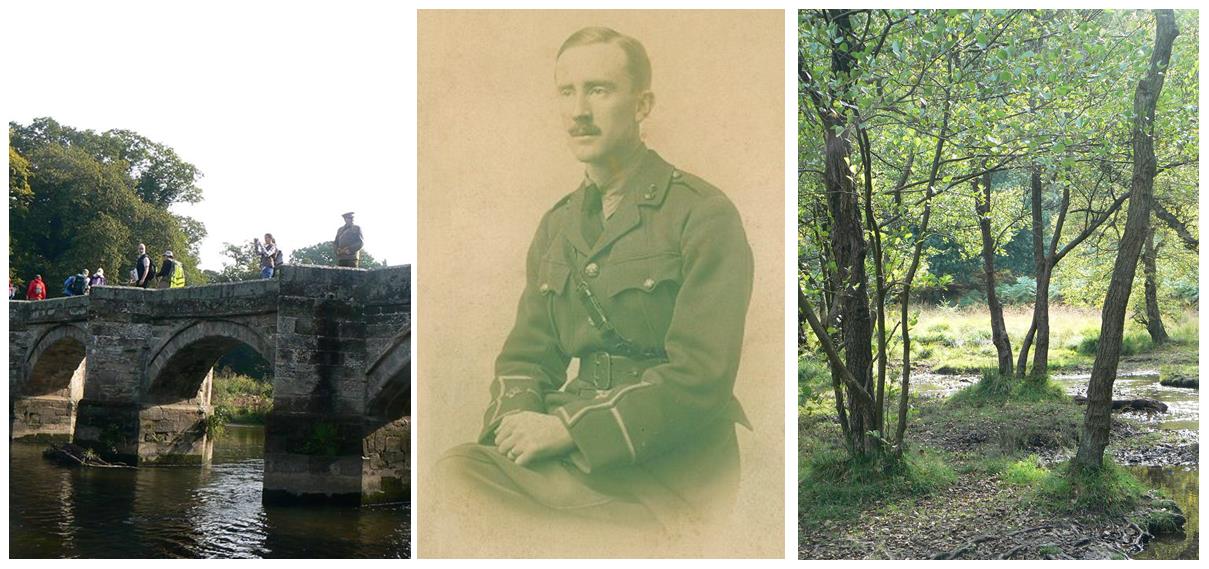
J.R.R.Tolkien – Soldier and Myth Maker
J.R.R Tolkien in Staffordshire 1915 – 1918 touring exhibition Launches March 2016
An exciting touring exhibition, organised by The Haywood Society, supported by the Staffordshire Libraries and Arts Service and the Museum of Cannock Chase and funded by The Heritage Lottery Fund is opening at the Museum on March 7th.
The exhibition focuses on the time that Tolkien spent in Staffordshire during the First World War highlighting the story for local residents, school groups, visitors to the county and interested groups such as The Tolkien Society and Tolkien scholars and enthusiasts.
Visitors to the exhibition, which will also be visiting several of the county’s libraries as part of a year-long tour, will be able to explore the writings, poetry and artwork that Tolkien wrote in Staffordshire as well as learn more about life for soldiers in Staffordshire during the Great War.
Original artwork, of domestic scenes and landscapes, which has not returned to Staffordshire since it left with Tolkien in 1918, will be on display as will photographs specially loaned by The Tolkien Estate and Bodleian Library. Tolkien’s daughter, Priscilla, writing in 1996, wrote of the many happy stories her parents would tell of their time at Gypsy Green, near Penkridge, in 1918, in particular the story of their landlords’ tame jackdaw which could speak and seemed to get up to constant mischief. The jackdaw can be seen on a vignette of family life titled ‘High Life at Gipsy Green’ in this exhibition.
During the Great War Second Lieutenant J. R. R. Tolkien of the Lancashire Fusiliers was stationed in Staffordshire, first at Whittington Heath, near Lichfield, next at a musketry camp at Newcastle-under-Lyme, then at Rugeley and Brocton Camps on Cannock Chase. After his marriage in March 1916 Tolkien’s wife came to live in Great Haywood so that she could be close to him. Tolkien regularly visited Edith in the village until he was posted to France in June 1916.
Tolkien returned to Great Haywood in early December 1916 to recover from his traumatic experiences at the Somme. He lived with Edith in a cottage there until late February 1917 and during this time created his first mythological stories, in part inspired by Staffordshire landscapes and experiences.
After a brief posting to East Yorkshire, Tolkien returned to Staffordshire in 1918 and lived in a cottage at Gipsy Green, Teddesley Park, near Penkridge, where other important work was undertaken.
The ‘Tolkien in Staffordshire’ story is one of war, comradeship, creativity, love and loss and this fascinating exhibition will offer visitors the chance to learn more about the early life and experiences of one of the world’s most well-known authors. Staffordshire, during the years of the Great War, was responsible for providing inspiration and illustration to J. R. R. Tolkien. It was a time of great turmoil and uncertainty, physical and emotional fragility and loss; he was flung into the most ghastly of wars which would scar a generation and his experiences on the bleak army camps, the village of Great Haywood and his wanderings in the county’s countryside inspired his creativity and led to immortalisation in his developing mythology and geography of what we now know as Middle-earth.
David Robbie, Project Leader for The Haywood Society, said: “We are thrilled to have received the support of the Heritage Lottery Fund and welcome the opportunity to tell the largely untold story of ‘Tolkien in Staffordshire’, which will have local, national and international appeal.”
Scott Whitehouse, Library Development Officer with Staffordshire Library and Arts, said: “We are delighted to have been able to support this project and to be offering so many people across Staffordshire an opportunity to discover their county’s connection with J.R.R. Tolkien by hosting the exhibition at six of our libraries. This story is a fascinating part of Staffordshire’s Great War heritage and will greatly enhance our cultural offer to communities over the coming year.”
Vanessa Harbar, Head of Heritage Lottery Fund West Midlands, said: “The impact of the First World War touched every corner of the UK. The Heritage Lottery Fund has already invested more than £70million in projects – large and small – that are marking this global Centenary; with our small grants programme, we are enabling even more communities, like those involved in the J. R. R. Tolkien in Staffordshire project, to explore the continuing legacy of this conflict and help local young people in particular to broaden their understanding of how it has shaped our modern world”.
